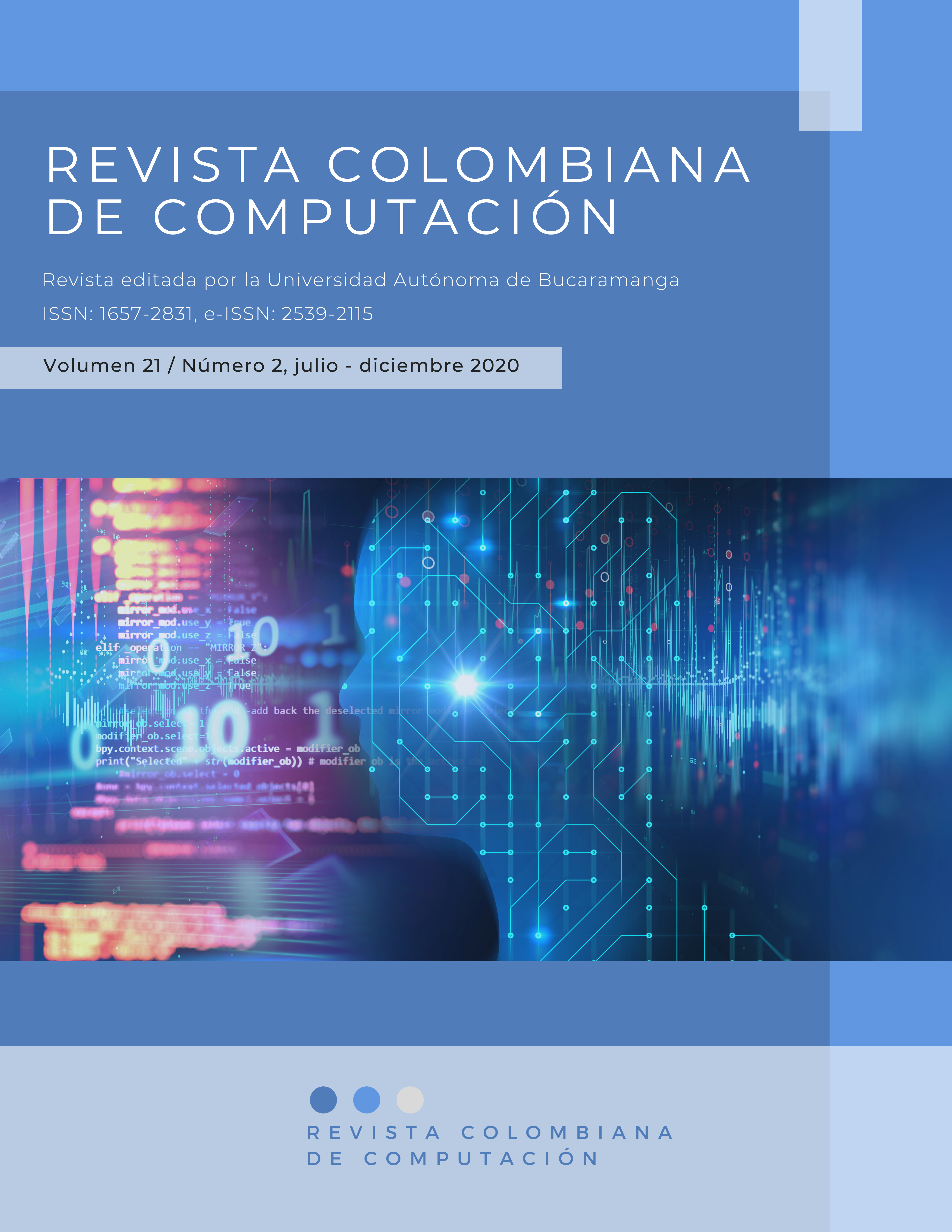Driver eXperience (DX): Una aproximación a la interacción en el vehículo
Resumen
La Experiencia de Usuario (UX) ha tenido un crecimiento en diferentes campos de la industria automotriz. Los vehículos se han convertido en un mundo lleno de oportunidades que le permiten al conductor sumergirse en un entorno de conectividad, comunicación, información y entretenimiento. Por lo tanto, es importante comenzar a darle al usuario un estudio más contextualizado, en donde no sea tratado como un individuo en general, sino más bien, por lo que realmente es, un conductor, con atributos y acciones propias de su rol en el vehículo. Este artículo presenta una definición subjetiva del término Driver eXperience (DX), y un conjunto de factores para tener en cuenta a fin de mejorar la relación vehículo-conductor, y así, brindarle al usuario una aproximación más comprensiva. Adicionalmente, se presenta un mapeo de la literatura de UX en la industria automotriz para entender la relevancia que puede tener introducir el término de DX.
Referencias bibliográficas
Battarbee, K. (2004). Co-experience: understanding user experiences in interaction [University of Art and Design Helsinki]. https://aaltodoc.aalto.fi/handle/123456789/11462
Blackwell, A. F., & Fincher, S. (2010). PUX: patterns of user experience. Interactions, 17(2), 27–31. https://doi.org/10.1145/1699775.1699782
Bloch, P. H. (1995). Seeking the Ideal Form: Product Design and Consumer Response. Journal of Marketing, 59(3), 16–29. https://doi.org/10.2307/1252116
Boehm-Davis, D. A., Green, P. A., Hada, H., Marcus, A., & Wheatley, D. (2003). The next revolution: Vehicle user-interfaces and the global rider/driver experience. Conference on Human Factors in Computing Systems - Proceedings, 708–709. https://doi.org/10.1145/765891.765941
Borchers, J. O., & Thomas, J. C. (2001). Patterns: what’s in it for HCI? CHI ’01 extended abstracts on Human factors in computing systems - CHI ’01, 225. https://doi.org/10.1145/634067.634201
Bosley, J. J. (2013). Creating a Short Usability Metric for User Experience (UMUX) Scale. Interacting with Computers, 25(4), 317–319. https://doi.org/10.1093/iwc/iwt007
Brooke, J. (1996). SUS: a “quick and dirty” usability scale. En P. W. Jordan, B. Thomas, B. A. Weerdmeester, & I. L. McClelland (Eds.), Usability evaluation in industry (pp. 189–194). Taylor & Francis Ltd.
Brookhuis, K. A., & de Waard, D. (2010). Monitoring drivers’ mental workload in driving simulators using physiological measures. Accident Analysis & Prevention, 42(3), 898–903. https://doi.org/10.1016/j.aap.2009.06.001
Cobo, M. J., López-Herrera, A. G., Herrera-Viedma, E., & Herrera, F. (2012). SciMAT: A new science mapping analysis software tool. Journal of the American Society for Information Science and Technology, 63(8), 1609–1630. https://doi.org/10.1002/asi.22688
da Silva, F. P. (2014). Mental Workload, Task Demand and Driving Performance: What Relation? Procedia - Social and Behavioral Sciences, 162, 310–319. https://doi.org/10.1016/j.sbspro.2014.12.212
Eggermeier, F. T., Gleen, W. F., Kramer, A. F., & Damos, D. L. (1991). Workload assessment in multi-task environments. En D. L. Damos (Ed.), Multiple Task Performance (pp. 207–216).
Forlizzi, J., & Battarbee, K. (2004). Understanding experience in interactive systems. Proceedings of the 2004 conference on Designing interactive systems processes, practices, methods, and techniques - DIS ’04, 261. https://doi.org/10.1145/1013115.1013152
Gefen, Karahanna, & Straub. (2003). Trust and TAM in Online Shopping: An Integrated Model. MIS Quarterly, 27(1), 51–90. https://doi.org/10.2307/30036519
Habib, K., Shalkamy, A., & El-Basyouny, K. (2019). Investigating the Effects of Mental Workload on Highway Safety. Transportation Research Record: Journal of the Transportation Research Board, 2673(7), 619–629. https://doi.org/10.1177/0361198119846474
Hassenzahl, M., & Tractinsky, N. (2006). User experience - a research agenda. Behaviour & Information Technology, 25(2), 91–97. https://doi.org/10.1080/01449290500330331
Hellweger, S., & Wang, X. (2015). What is User Experience Really: towards a UX Conceptual Framework. arXiv. http://arxiv.org/abs/1503.01850
International Organization for Standardization. (2018). ISO 9241-11:2018: Ergonomics of human-system interaction — Part 11: Usability: Definitions and concepts. https://www.iso.org/obp/ui/#iso:std:iso:9241:-11:ed-2:v1:en
Kaiser, T., Perterer, N., Meschtrcherjakov, A., & Mirning, A. (2016). Car User Experience Patterns: A Pattern Collection in Progress. The Eighth International Conferenceon Pervasive Patterns and Applications.
Karapanos, E., Zimmerman, J., Forlizzi, J., & Martens, J.-B. (2009). User experience over time. Proceedings of the 27th international conference on Human factors in computing systems - CHI 09, 729. https://doi.org/10.1145/1518701.1518814
Law, E. L.-C., van Schaik, P., & Roto, V. (2014). Attitudes towards user experience (UX) measurement. International Journal of Human-Computer Studies, 72(6), 526–541. https://doi.org/10.1016/j.ijhcs.2013.09.006
Lee, J. D., & See, K. A. (2004). Trust in Automation: Designing for Appropriate Reliance. Human Factors: The Journal of the Human Factors and Ergonomics Society, 46(1), 50–80. https://doi.org/10.1518/hfes.46.1.50_30392
Lewis, M., Sycara, K., & Walker, P. (2018). The Role of Trust in Human-Robot Interaction. En H. A. Abbass, J. Scholz, & D. J. Reid (Eds.), Foundations of Trusted Autonomy. Studies in Systems, Decision and Control (pp. 135–159). Springer, Cham. https://doi.org/10.1007/978-3-319-64816-3_8
Li, R., Chen, Y. V., Sha, C., & Lu, Z. (2017). Effects of interface layout on the usability of In-Vehicle Information Systems and driving safety. Displays, 49, 124–132. https://doi.org/10.1016/j.displa.2017.07.008
Mayer, R. C., Davis, J. H., & Schoorman, F. D. (1995). An Integrative Model Of Organizational Trust. Academy of Management Review, 20(3), 709–734. https://doi.org/10.5465/amr.1995.9508080335
Medina-Lopez, C., Marin-Garcia, J. A., & Alfalla-Luque, R. (2010). Una propuesta metodológica para la realización de búsquedas sistemáticas de bibliografía (A methodological proposal for the systematic literature review). WPOM-Working Papers on Operations Management, 1(2), 13–30. https://doi.org/10.4995/wpom.v1i2.786
Michon, J. A. (1985). A Critical View of Driver Behavior Models: What Do We Know, What Should We Do? En L. Evans & R. C. Schwing (Eds.), Human Behavior and Traffic Safety (pp. 485–524). Springer, Boston, MA. https://doi.org/10.1007/978-1-4613-2173-6_19
Norman, D., & Nielsen, J. (2014). The Definition of User Experience (UX). https://www.nngroup.com/articles/definition-user-experience/
Orlovska, J., Wickman, C., & Söderberg, R. (2018). Big data analysis as a new approach for usability attributes evaluation of user interfaces: an automotive industry context. En D. Marjanović, M. Štorga, N. Škec, S.;Bojčetić, & N. Pavković (Eds.), DS 92: Proceedings of the DESIGN 2018 15th International Design Conference (pp. 1651–1662). https://doi.org/10.21278/idc.2018.0243
Pavlou, P. A., & Gefen, D. (2004). Building Effective Online Marketplaces with Institution-Based Trust. Information Systems Research, 15(1), 37–59. https://doi.org/10.1287/isre.1040.0015
Raats, K., Fors, V., & Pink, S. (2020). Trusting autonomous vehicles: An interdisciplinary approach. Transportation Research Interdisciplinary Perspectives, 7, 100201. https://doi.org/10.1016/j.trip.2020.100201
Ross, J. (2014). The Business Value of User Experience. http://www.infragistics.com/media/335732/the_business_value_of_user_experience-3.pdf
Shimizu, K. (2017). Technological development in automotive industry and transformation in corporate governance system. Journal of Governance and Regulation, 6(3), 46–54. https://doi.org/10.22495/jgr_v6_i3_p5
Tscheligi, M. (2012). UX Design for vehicles [Conference presentation]. AutomotiveUI ’12: International Conference on Automotive User Interfaces and Interactive Vehicular Applications. http://www.auto-ui.org/12/adjunct-proceedings/t5-ux-design-vehicles-tscheligi.pdf
van Schaik, P., & Ling, J. (2008). Modelling user experience with web sites: Usability, hedonic value, beauty and goodness. Interacting with Computers, 20(3), 419–432. https://doi.org/10.1016/j.intcom.2008.03.001
Wang, B., Hensher, D. A., & Ton, T. (2002). Safety in the road environment: A driver behavioural response perspective. Transportation, 29(3), 253–270. https://doi.org/10.1023/A:1015661008598
Descargas












